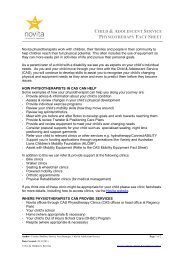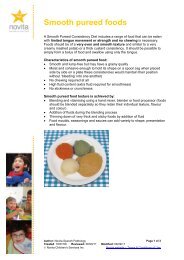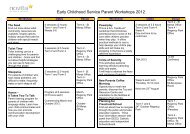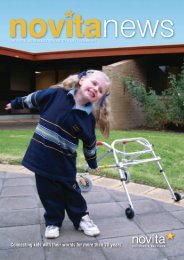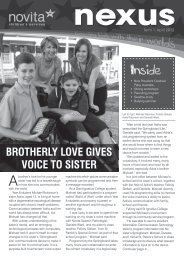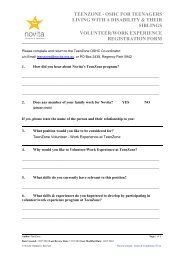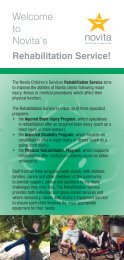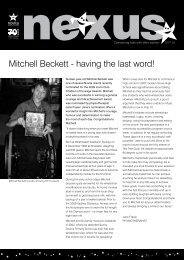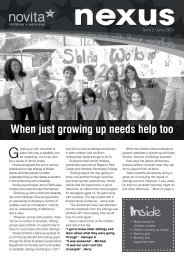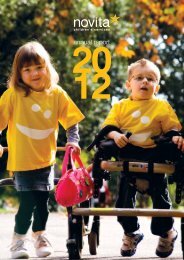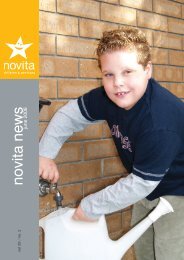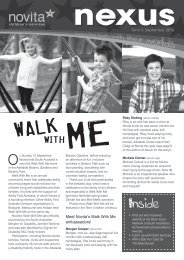Novita Research Report - 2004 to 2007 - Novita Children's Services
Novita Research Report - 2004 to 2007 - Novita Children's Services
Novita Research Report - 2004 to 2007 - Novita Children's Services
- No tags were found...
You also want an ePaper? Increase the reach of your titles
YUMPU automatically turns print PDFs into web optimized ePapers that Google loves.
21SummaryDynamic equinus (spasticity of the calf muscles) occurs commonly in children with cerebralpalsy and is the focus of numerous treatments including serial casting, orthoses, nightsplinting, injection with BoNT-A and physiotherapy. It is now common practice in SouthAustralia <strong>to</strong> use serial casting routinely as adjunctive treatment post-BoNT-A, on the premisethat it will enhance and increase the duration of the effects of BoNT-A treatment. Howeverthere is very little evidence available supporting the use of such combination interventions forchildren with cerebral palsy.This study aims <strong>to</strong> investigate the role of serial casting post-BoNT-A injections for childrenwith cerebral palsy and develop clinical and functional indica<strong>to</strong>rs for casting selection afterBoNT-A treatment.Method<strong>Novita</strong> clients with hemiplegic or diplegic cerebral palsy aged between two and 16 years,who had planned <strong>to</strong> have BoNT-A treatment <strong>to</strong> their calf muscles, were invited <strong>to</strong> participate.Consenting participants had measures prior <strong>to</strong> BoNT-A treatment, then at four weeks, 12weeks and six months post-BoNT-A injection. Outcome measures included calf range ofmotion (goniometry), spasticity (Tardieu and Modified Ashworth Scale), Selective Mo<strong>to</strong>rControl, gait analysis (Observational Gait Scale), level of gross mo<strong>to</strong>r function (Gross Mo<strong>to</strong>rFunction Measure) and parental/child goals (Canadian Occupational Performance Measure).Ten days post-BoNT-A injection, participants were reviewed by the research team forconsideration for serial casting. Participants deemed as meeting <strong>Novita</strong>’s current castingcriteria were randomly assigned <strong>to</strong> either a casting or a control (no casting) group usingminimisation. This method allowed for the two groups <strong>to</strong> be matched for age range (two <strong>to</strong>five, six <strong>to</strong> nine or 10-16 years), diagnosis (hemiplegia or diplegia) and GMFCS level (I, II orIII) while maintaining an element of randomisation. All participants received night splints,orthoses (where required), exercises and an exercise diary.Appropriate statistics will be used <strong>to</strong> determine if there are differences between the treatmentgroups for the outcome measures.ResultsImplicationsTwenty three participants (six hemiplegia, 17 diplegia) were recruited. GMFCS levels ofparticipants were level I (14), level II (six) and level III (three). Ages at BoNT-A injectionwere two <strong>to</strong> five years (13), six <strong>to</strong> nine years (nine) and 10-16 years (one). All data hasbeen completed for 20 participants, follow-up measures are being completed for threeparticipants, with the last participant due for measures in early November <strong>2007</strong>.For clients – <strong>to</strong> ensure children with cerebral palsy and their families, receive the best practicemanagement for dynamic equines.For services – the findings of this study will ensure physiotherapists use resources suchas therapy time and splinting materials efficiently and in accordance with evidence-basedpractice.StatusOngoing




